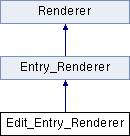 |
GravityView
2.17
The best, easiest way to display Gravity Forms entries on your website.
|
 |
GravityView
2.17
The best, easiest way to display Gravity Forms entries on your website.
|
If this file is called directly, abort. More...

Public Member Functions | |
| render (Entry $entry, View $view, Request $request=null) | |
| Renders a an editable instance. More... | |
 Public Member Functions inherited from Entry_Renderer Public Member Functions inherited from Entry_Renderer | |
| render (Entry $entry, View $view, Request $request=null) | |
| Renders a single instance. More... | |
 Public Member Functions inherited from Renderer Public Member Functions inherited from Renderer | |
| __construct () | |
| Initialization. More... | |
| legacy_template_warning ( $view, $path) | |
| Warn about legacy template being used. More... | |
Additional Inherited Members | |
 Static Public Member Functions inherited from Renderer Static Public Member Functions inherited from Renderer | |
| static | maybe_print_notices ( $gravityview=null) |
| Print unconfigured notices to admins. More... | |
If this file is called directly, abort.
The class.
The edit entry renderer.
Definition at line 14 of file class-gv-renderer-entry-edit.php.
Renders a an editable instance.
| \GV\Entry | $entry | The Entry instance to render. |
| \GV\View | $view | The View connected to the entry. |
| \GV\Request | $request | The request context we're currently in. Default: gravityview()->request |
Definition at line 30 of file class-gv-renderer-entry-edit.php.
References $entries, Legacy_Context\pop(), and Legacy_Context\push().